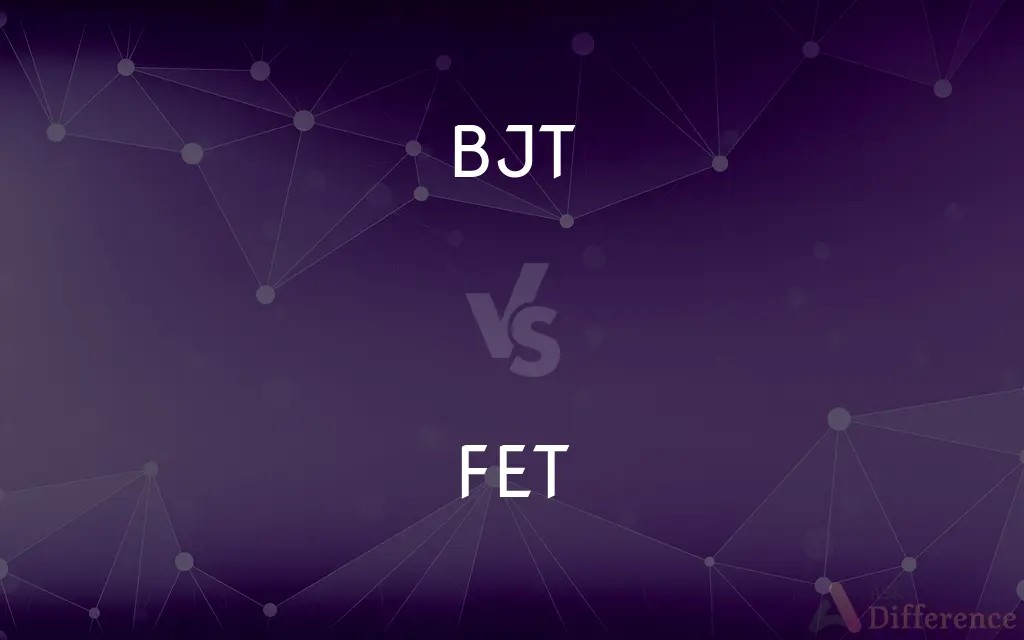BJT vs. FET — What's the Difference?
By Tayyaba Rehman — Published on December 5, 2023
BJT (Bipolar Junction Transistor) is a current-controlled device with three layers of semiconductor material, whereas FET (Field Effect Transistor) is a voltage-controlled device that uses an electric field to control the electrical behavior.

Difference Between BJT and FET
Table of Contents
ADVERTISEMENT
Key Differences
BJT, or Bipolar Junction Transistor, is a type of transistor made up of three layers of semiconductor material. This configuration creates two PN junctions. On the other hand, FET, which stands for Field Effect Transistor, primarily relies on an electric field to control its electrical characteristics.
In terms of operation, the BJT is current-controlled, meaning the output current is primarily a function of the input current. Conversely, the FET is voltage-controlled, meaning its output current is mainly governed by the input voltage applied to it.
BJTs come in two main types: NPN and PNP, based on the arrangement of the N-type and P-type materials. FETs, meanwhile, are divided into JFETs (Junction Field Effect Transistors) and MOSFETs (Metal-Oxide-Semiconductor Field Effect Transistors), with each having its distinct applications and characteristics.
Regarding applications, BJTs are often used in amplifying circuits due to their linear characteristics. In contrast, FETs are frequently employed in switching applications and circuits where high input impedance is beneficial.
Finally, one of the salient differences between BJT and FET lies in their power consumption. BJTs generally consume more power compared to FETs. As a result, FETs are often preferred in battery-powered devices due to their energy efficiency.
ADVERTISEMENT
Comparison Chart
Operation Control
Current-controlled
Voltage-controlled
Structure
Three layers of semiconductor (NPN or PNP)
Relies on electric fields (JFET or MOSFET)
Main Applications
Amplifying circuits
Switching applications and high input impedance circuits
Power Consumption
Generally higher
Typically lower, more energy-efficient
Input Impedance
Lower
Higher
Compare with Definitions
BJT
Known for its linear amplifying characteristics.
Because of its properties, a BJT is preferred in several analog applications.
FET
A voltage-controlled semiconductor device.
The FET's behavior changes based on the voltage applied to its gate.
BJT
A current-controlled semiconductor device.
The BJT is popularly used in many amplifying circuits.
FET
Comes in JFET and MOSFET variants.
Depending on the application, one might choose between a JFET or a MOSFET.
BJT
A transistor with three semiconductor layers.
The arrangement of layers in a BJT can either be NPN or PNP.
FET
Utilizes electric fields to control its behavior.
In a FET, the electric field plays a crucial role in its operation.
BJT
Device with two PN junctions.
The dual PN junctions in the BJT make it distinct from the FET.
FET
Known for high input impedance.
Circuits requiring high input impedance often utilize FETs.
BJT
Consumes more power than FETs.
For battery-driven devices, BJTs might not be the first choice due to their power consumption.
FET
Energy-efficient compared to BJTs.
For energy-sensitive designs, FETs are often the preferred choice.
FET
(obsolete) to fetch
FET
(obsolete) a piece
FET
A piece.
FET
To fetch.
And from the other fifty soon the prisoner fet.
FET
Fetched.
FET
A transistor in which most current flows in a channel whose effective resistance can be controlled by a transverse electric field
Common Curiosities
Into what categories are FETs mainly divided?
FETs are mainly divided into JFETs (Junction Field Effect Transistors) and MOSFETs (Metal-Oxide-Semiconductor Field Effect Transistors).
How does a BJT differ in operation from an FET?
A BJT is current-controlled, while an FET is voltage-controlled.
What are the two main types of BJTs?
The two main types of BJTs are NPN and PNP.
What is the primary factor controlling a FET's output?
The primary factor controlling a FET's output is the input voltage.
Which transistor uses an electric field to control its behavior?
The FET (Field Effect Transistor) uses an electric field for control.
Which device is typically used in amplifying circuits?
BJTs are often used in amplifying circuits.
What does BJT stand for?
BJT stands for Bipolar Junction Transistor.
Which device, BJT or FET, is more energy-efficient?
The FET is generally more energy-efficient than the BJT.
How many semiconductor layers does a BJT have?
A BJT has three semiconductor layers.
Which device, BJT or FET, is preferred for switching applications?
FETs are often preferred for switching applications.
Are BJTs and FETs used in digital circuits?
Both BJTs and FETs can be used in digital circuits, but FETs, especially MOSFETs, are more commonly used in modern digital integrated circuits.
In terms of power consumption, which device is preferred for battery-powered applications?
FETs are preferred for battery-powered applications due to their lower power consumption.
Can FETs be used in analog circuits?
Yes, FETs can be used in analog circuits and are especially useful where high input impedance is needed.
Between BJTs and FETs, which one typically has a faster response time?
Generally, FETs can offer faster response times than BJTs, especially in certain switching applications.
How do the input impedances of BJTs and FETs compare?
FETs typically have a higher input impedance compared to BJTs.
Share Your Discovery

Previous Comparison
Pressed Powder vs. Loose Powder
Next Comparison
Anterior Pituitary Gland vs. Posterior Pituitary GlandAuthor Spotlight
Written by
Tayyaba RehmanTayyaba Rehman is a distinguished writer, currently serving as a primary contributor to askdifference.com. As a researcher in semantics and etymology, Tayyaba's passion for the complexity of languages and their distinctions has found a perfect home on the platform. Tayyaba delves into the intricacies of language, distinguishing between commonly confused words and phrases, thereby providing clarity for readers worldwide.
















































